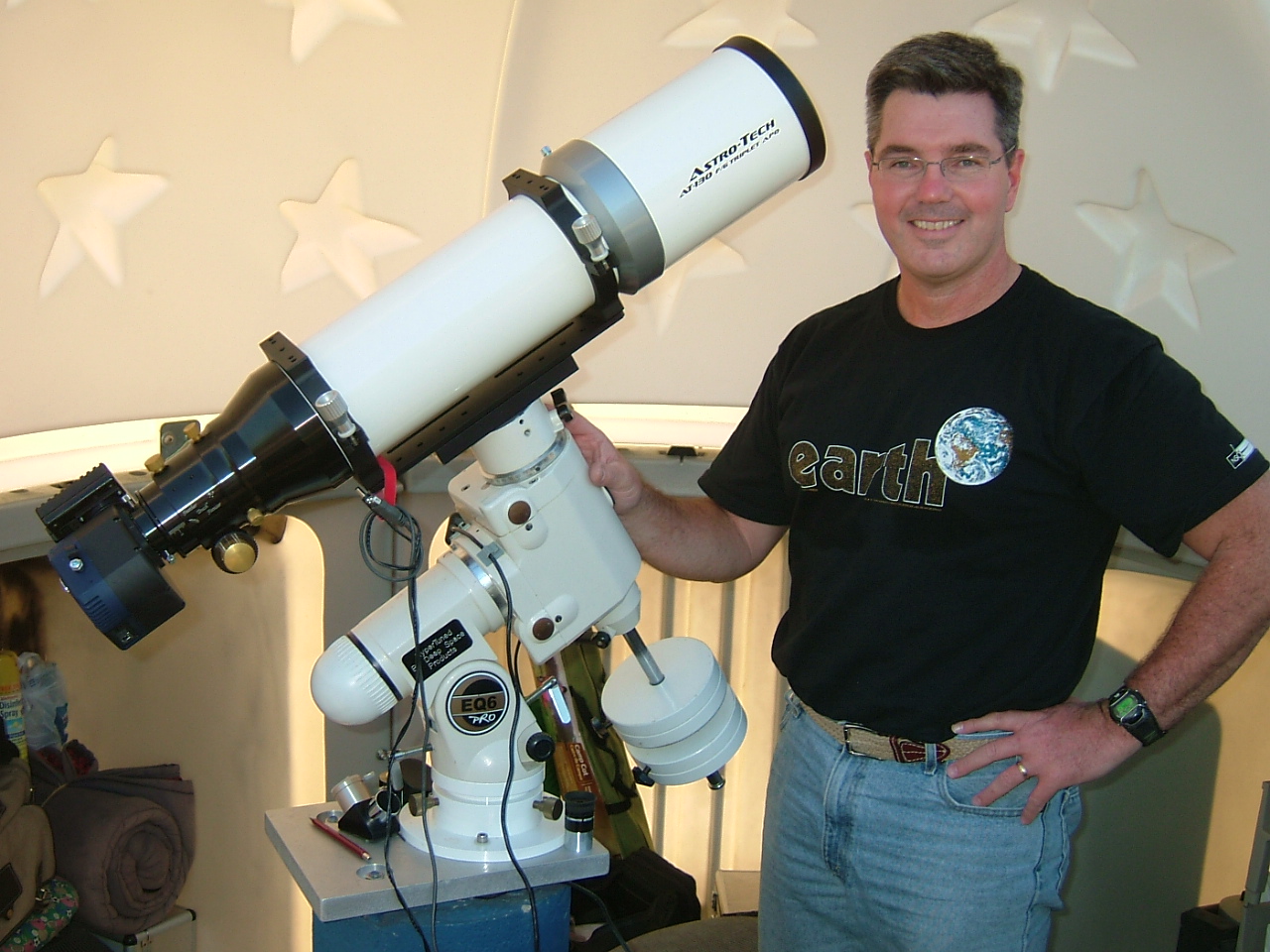…and not be disappointed.
Part I: The Mount
Hopefully if you are one of those special people with a newfound interest in amateur astronomy and have gotten this far, you know the Golden Rule of Telescope Purchase. For those of you starting here, the Golden Rule is:

DO NOT BUY A TELESCOPE AT A DEPARTMENT STORE OR BIG BOX STORE.
If you are busy and/or don’t like to read very much, then you just have to read the following paragraph to know all you need to avoid buying a useless telescope as a Christmas gift. Follow the Golden Rule above and DO NOT buy it at a local big box department store because you will only buy a cheaply made, unfocusable, unsteady, non-pointing bucket of trouble.
DO buy about a 4”-6” reflecting telescope on a Dobson mount. The BEST telescope for a young person, beginner is by far the STARBLAST. You can buy a new one for less than $200 with free shipping. Go here to order one tinyurl.com/6rrrd93 (To avoid overt advertising, I made the URL tiny to hide the manufacturer, but it’s good equipment that you cannot find at any big box store).
Once you have the scope, buy a zero-reflex finder, either a TELRAD or a Rigel QuikFinder and ditch the hard to use finder scope. Then download star charts for your location from for free here fourmilab.ch/yoursky (just click “set for a local city” and scroll down to Dallas…close enough). Wait until there is no Moon in the sky and just go out and compare the star chart to the night sky by holding it up as described and move the telescope to the object you want to see. Congratulations! You have conquered amateur astronomy.
When you buy a telescope, remember that it’s really a system of two parts, the mount and the telescope (optical tube – OT) itself. The most important and unfortunately overlooked aspect of the telescope system is the mount, for it determines how the optics are applied against your search of the night sky. Even some “experienced” amateurs forget this point as illustrated in the very writing of this article…the person who asked me to write this actually wrote about optical tubes first.
Mounts come in several varieties ranging from your arms holding a pair of binoculars to a fully computerized, remotely operated system. Forget that last part if you are just getting into this hobby. Before we look closely at the mount, consider that the mount itself determines what your optical tube can be used to see or even what you can eventually image with a camera. Telescope mounts come in the following varieties from least complex to most complex.
- Handheld – For binoculars or other viewing system
- Alt-Azimuth
- Dobsonian (named after John Dobson)
- Equatorial Mount
- Fork Mount
For our purposes, both the fork mount and equatorial mounts sit atop a simple tripod system that comes with the mount itself as an integral part. The big differences in these mounts are in whether they track the sky automatically, how they move, and how they align.
The simplest type of mount is your pair of arms. Believe it or not, if you learn how to read a simple star chart (covered in another section of this exciting series) and learn how to “aim” your body using your shoulders, the human body makes a very good telescope pointing and aiming system. My favorite beginner star chart that always “gets you in the ballpark” is produced by Fourmilab and can be downloaded for free here fourmilab.ch/yoursky.
The next simplest type of mount is the kind usually found by those who violate the Golden Rule of telescope purchase (see above) when they buy a scope at their local big box retailer that offers 600X Magnificent Magnification to enable viewing slimy green space aliens on Mars. Yes, this is the alt-azimuth telescope mount (Fig 1). BEWARE. This mount has two perpendicular axes of motion, vertical (altitude) and horizontal (azimuth). Standard camera tripods have alt-azimuth mounts. These mounts are usually mated to the optical tube, badly aligned, shaky and make tracking the sky almost impossible at all but the lowest magnification.
Now we’re going to see another type of Alt-azimuth mount, that really makes life easy for the new observer. One of my personal favorites is the Dobsonian or “Dob” mounted telescope. The Dobsonian telescope takes its name from the astronomer/philosopher John Dobson, who introduced the concept of inexpensive, large aperture telescopes to astronomy and founded the San Francisco Sidewalk Astronomers. Amateur astronomers at the time were so amazed that a telescope built from simple, inexpensive materials performed so well that they could hardly believe their eyes. As home-built Dobsonians started showing up at star parties and people saw what Donsonians could do, the Dobsonian revolution swept the world.

This is the scope recommended in the beginning of the article. The Dob is a system unto itself but for this discussion just consider that when you set up your telescope, you move the base and then set the optical tube into the base and just point it at the target you are interested in viewing.
Several years ago, only the most advanced models of these scopes would find and track an object with a computer assist, but nowadays there are several versions that align simply and accurately with only a few alignment star inputs into a user friendly box.
I personally have owned two “Dobs” one a ten-inch and my current “light bucket” is a 16-inch telescope. The one big important thing about any Dob is having an accurately aligned finder scope system. My suggestion is that the newcomer should buy a 4-inch to 6-inch Dob (that was a recommendation) but whatever kind of Dob you purchase, please spend an extra $30 on some sort of Zero magnification, Reflex finder. My two favorite zero mag finders are the TELRAD and the Rigel QuickFinder. I currently operate both of these finders on my telescopes.
The Equatorial Mount
The equatorial mount has two perpendicular axes, but they are called right ascension (R.A. or polar)

and declination (Dec). When the RA axis is aligned parallel with the Earth’s rotational axis, objects can be easily “tracked” as they drift across the sky (due to Earth’s rotation) by turning just one of the slow-motion controls (R.A.) instead of two, as is required with an alt-azimuth mount. A motor drive can be coupled to the R.A. axis for automatic sky tracking. Sounds complicated and sort of is complicated because in order to have any chance of an accurate alignment, one must accurately align the polar axis of the mount to what we call “Polar North”. In the United States this is pretty simple as long as you have a polar finder scope in the mount, know what time it is, and have a way to identify the astronomical or “Sidereal” time. I don’t recommend purchasing an equatorial mount on your first go unless you’re pretty space savvy. The image in Fig. 3 illustrates perhaps the most inexpensive type of equatorial mount, but don’t be deceived as these mounts really form the basis of the high-end of science being performed today by the top amateur astrophotographers and researchers.
Finally, we’ll look at one of the more popular telescope mounts, the Fork Mount. I have owned two systems with fork mounts and both provided hundreds of hours of excellent astronomical viewing and imaging, however I “dismounted” my observatory based telescope from its forks about a year ago in favor of an equatorial mount because it tracks and points at the sky more accurately.

Several commercial manufacturers, namely Meade and Celestron, have made fork mounts popular. With most fork mounts comes a computerized capability right in your hands.
Using a thing called a hand paddle, which is really a mini-computer processor with memory and everything, you simply tell the telescope where you are, what time it is and point it at a couple objects in the sky and you have an alignment. Several years ago, Meade added a simple function that allows you to enter your zip code, as the location can’t be easier than that.
The downside to all this automation is that when you press “Go-To” an object, if the telescope doesn’t put the object in your eyepiece or finder scope, the mount is really not very user friendly in terms of searching the sky for the object.
However, there are some simple fixes to better enable this search process. On my 10-inch Meade LX200 I removed the little finder scope so I could have a second imaging telescope and added a TELRAD zero-mag finder. One of the most appealing aspects of a fork-mounted telescope is its ability to accurately track objects in the sky. You might find that you like to take pictures of the night sky and this kind of mount will allow you to do just that for several seconds at a time.

Unfortunately, when the mount is sitting “flat,” any images of longer duration than maybe 30-seconds will result in a thing called “star-trailing” that is most pronounced at the edges of the image. But wait – there’s a solution to this problem. You can make your alt-az fork mounted telescope into an equatorially based fork mount by placing it on a thing astronomers call a “wedge”. In this photo (left) you can see what my Meade used to look like in my observatory before I dismounted it in favor of a German equatorial mount.
Meade and Celestron both manufacture wedges but they are unsteady and cheaply made in my opinion. So by the time you decide you need a wedge to support what may become your new “addiction” to astrophotography, you may want to consider a high-end wedge such as a Milburn or Mitty product. The robust wedge in this photo is an aerospace grade aluminum Milburn wedge.
Obviously, there are many choices for telescope mounts. Stay tuned — Part II of the story shall be revealed in a detailed discussion of the telescope tube or what people normally consider to be “the telescope.”
 Our Universe Today is a column written by Blue Ribbon News special contributor, Max Corneau, who has lived in Rockwall with his family since 2000. Max retired from the U.S. Army in 2009 as a Lieutenant Colonel, Senior Space Operations Officer and Master Aviator. He amassed over 3,200 hours as a pilot of Special Electronic Mission Airplanes. Since 2004 he has been a NASA/JPL Solar System Ambassador, is a Master of Astronomical Outreach through the Astronomcial League and built his own astronomical observatory. His amazing images can be seen at AstroDad.com.
Our Universe Today is a column written by Blue Ribbon News special contributor, Max Corneau, who has lived in Rockwall with his family since 2000. Max retired from the U.S. Army in 2009 as a Lieutenant Colonel, Senior Space Operations Officer and Master Aviator. He amassed over 3,200 hours as a pilot of Special Electronic Mission Airplanes. Since 2004 he has been a NASA/JPL Solar System Ambassador, is a Master of Astronomical Outreach through the Astronomcial League and built his own astronomical observatory. His amazing images can be seen at AstroDad.com.
Read Max’s column about Earth’s closest encounter with a space rock here.
Check out Max’s column about NASA’s recent launch of the Mars Science Lab, too.
To submit your news, events, or a guest column on your area of expertise, email editor@BlueRibbonNews.com.



